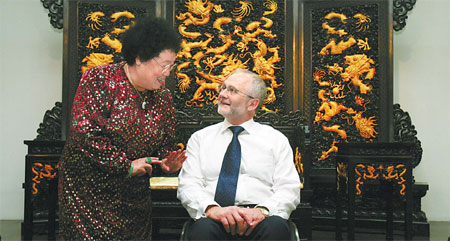 |
|
Chan Laiwa talks about red sandalwood with Philip Craven, the president of the International Paralympic Committee, during his visit to the China Red Sandalwood Museum. [Lu Zhongqiu]
|
Chan Laiwa is never happier than when she greets her grandchildren after school, dines each evening with her family, makes and shares her mooncakes or harvests the fields she has tended for months.
In the eyes of her staff, the 68-year-old is an ordinary person. But she isn't.
The businesswoman has been listed as one of the wealthiest woman in China by Forbes for several years, with a fortune estimated in 2008 at $793 million.
What the Hongkonger feels most proud of, however, is neither her enormous wealth nor her successful investment in real estate and hotels, among them Beijing's Jinbao Street and The Regent Beijing.
It's the China Red Sandalwood Museum (CRSM), which claims to be the world's largest private museum specializing in the precious hardwood.
Having developed a lifelong passion for red sandalwood, the president of Fu Wah International Group (FWIG) built the museum in Beijing with an investment of $29 million a decade ago.
The 25,000-sq-m museum displays Chan's collection of more than 300 pieces from the Ming (1368-1644) and Qing (1644-1911) dynasties. More than 2,000 exhibits have come out of her workshop over the past two decades.
 |
|
A replica Qing-style red sandalwood table with flat ends and lotus patterns. The original piece was collected by the Beijing Palace Museum. [Courtesy of China Red Sandalwood Museum]
|
"Our museum is different from others because it never collects or buys any red sandalwood furniture from the public. It is just a place to showcase the treasures, and to inherit and pass on red sandalwood art," she says.
Red sandalwood is among the most precious woods in the world, partly because it grows extremely slowly and partly because up to 90 percent of mature trees are hollow and not suitable to be used for furniture. So, there is a saying that "red sandalwood has the same price as gold".
The dark purple and black wood represented the solemnity and magnificence of imperial rule in ancient times, when only the royal family made furniture from it.
Fair-skinned and ruddy-cheeked, Chan looks much younger than most people her age.
She may wear a jade necklace but she doesn't flaunt her wealth. There is no Louis Vuitton handbag and no Chanel fashion clothes.
What she wears all the time is a round-neck dress that makes her feel at ease. Changes are made to the sleeves and material according to the seasonal differences, and Chinese red is her favorite color.
Chan lives in a world of red sandalwood. The meeting room in her Beijing home is largely furnished with the hardwood furniture and she sleeps in a red sandalwood bed, believing it brings her beauty and health.
She also says a person's beliefs are shaped during childhood and for that reason she is grateful to her father.
She was born to a noble Manchu family of the Yellow Banner clan in Beijing. Her home was filled with antique beds, cabinets and painting tables made of hardwood, including red sandalwood and huanghuali wood.
Chan's father knew red sandalwood well. He often told his daughter it was so precious even a broken piece should not be neglected, rather displayed on a wall and preserved.
Since then, Chan has had a special affection for red sandalwood and the culture of traditional Chinese furniture.
Many of the ancient treasures were confiscated during the "cultural revolution" (1966-76) but even then, Chan managed to hide some pieces.
In the 1970s, Chan moved to Hong Kong, where she accumulated her wealth in the real estate business. All the time, though, she took every chance she had to collect more wood, even visiting virgin forests on the India-Myanmar border to collect the logs.
Chan then switched her attention to China's economic reforms and toward the end of the 1980s returned to Beijing looking for opportunities.
"As a businesswoman, I have benefited from the country's economic reforms," she says. "A big thank-you to Deng Xiaoping, who revived the country."